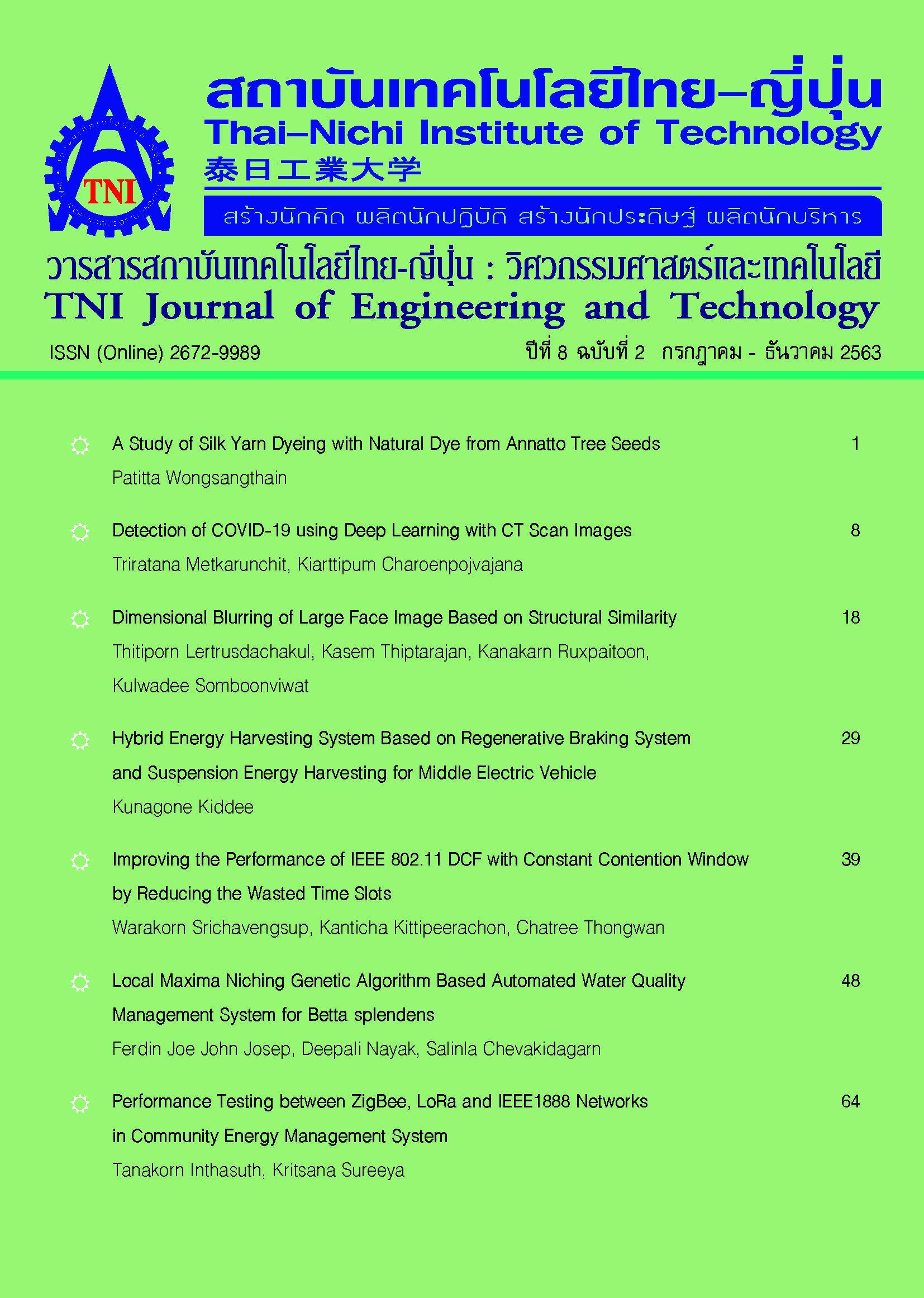การปรับปรุงประสิทธิภาพของอัลกอริทึม IEEE 802.11 DCF ที่ใช้ขนาดเฟรมคงที่ โดยการลดช่องสัญญาณที่สูญเปล่า
Main Article Content
บทคัดย่อ
ในการเข้าใช้ช่องสัญญาณของอัลกอริทึม IEEE 802.11 DCF ที่ใช้ขนาดเฟรมคงที่ อาจจะมีช่องสัญญาณท้ายเฟรมที่ไม่มีผู้ใช้รายใดเข้าใช้งาน ซึ่งส่งผลให้เกิดช่องสัญญาณที่สูญเปล่า บทความนี้จึงนำเสนอวิธีการปรับปรุงประสิทธิภาพของอัลกอริทึม IEEE 802.11 DCF ที่ใช้ขนาดเฟรมคงที่ โดยใช้วิธีการลดช่องสัญญาณที่สูญเปล่าท้ายเฟรม บทความฉบับนี้นำเสนอ 2 อัลกอริทึม ซึ่งได้แก่ อัลกอริทึมการลดช่องสัญญาณที่สูญเปล่าในเฟรมสุดท้าย และอัลกอริทึมการลดช่องสัญญาณที่สูญเปล่าในทุกเฟรม จากผลการทดสอบพบว่า อัลกอริทึมการลดช่องสัญญาณที่สูญเปล่าในทุกเฟรมมีประสิทธิภาพที่ดีที่สุด และอัลกอริทึมการลดช่องสัญญาณที่สูญเปล่าในเฟรมสุดท้ายมีประสิทธิภาพที่ดีกว่าอัลกอริทึม IEEE 802.11 DCF ที่ใช้ขนาดเฟรมคงที่ โดยอัลกอริทึมที่นำเสนอทั้ง 2 วิธี สามารถปรับปรุงสมรรถนะของระบบได้ดี โดยเฉพาะกรณีที่มีจำนวนช่องสัญญาณต่อเฟรมมาก ทั้งนี้ควรเลือกใช้จำนวนช่องสัญญาณต่อเฟรมที่เหมาะสมกับจำนวนผู้ใช้งานในระบบ เพื่อให้ได้ประสิทธิภาพของระบบดีที่สุด
Article Details
นโยบายการรับบทความ
กองบรรณาธิการวารสารสถาบันเทคโนโลยีไทย-ญี่ปุ่น มีความยินดีรับบทความจากอาจารย์ประจำ และผู้ทรงคุณวุฒิในสาขาวิศวกรรมศาสตร์และเทคโนโลยี ที่เขียนเป็นภาษาไทยหรือภาษาอังกฤษ ซึ่งผลงานวิชาการที่ส่งมาขอตีพิมพ์ต้องไม่เคยเผยแพร่ในสิ่งพิมพ์อื่นใดมาก่อน และต้องไม่อยู่ในระหว่างการพิจารณาของวารสารอื่นที่นำส่ง ดังนั้นผู้สนใจที่จะร่วมเผยแพร่ผลงานและความรู้ที่ศึกษามาสามารถนำส่งบทความได้ที่กองบรรณาธิการเพื่อเสนอต่อคณะกรรมการกลั่นกรองบทความพิจารณาจัดพิมพ์ในวารสารต่อไป ทั้งนี้บทความที่สามารถเผยแพร่ได้ประกอบด้วยบทความวิจัย ผู้สนใจสามารถศึกษาและจัดเตรียมบทความจากคำแนะนำสำหรับผู้เขียนบทความ
การละเมิดลิขสิทธิ์ถือเป็นความรับผิดชอบของผู้ส่งบทความโดยตรง บทความที่ได้รับการตีพิมพ์ต้องผ่านการพิจารณากลั่นกรองคุณภาพจากผู้ทรงคุณวุฒิและได้รับความเห็นชอบจากกองบรรณาธิการ
ข้อความที่ปรากฏภายในบทความของแต่ละบทความที่ตีพิมพ์ในวารสารวิชาการเล่มนี้ เป็น ความคิดเห็นส่วนตัวของผู้เขียนแต่ละท่าน ไม่เกี่ยวข้องกับสถาบันเทคโนโลยีไทย-ญี่ปุ่น และคณาจารย์ท่านอื่น ๆ ในสถาบัน แต่อย่างใด ความรับผิดชอบด้านเนื้อหาและการตรวจร่างบทความแต่ละบทความเป็นของผู้เขียนแต่ละท่าน หากมีความผิดพลาดใด ๆ ผู้เขียนแต่ละท่านจะต้องรับผิดชอบบทความของตนเองแต่ผู้เดียว
กองบรรณาธิการขอสงวนสิทธิ์มิให้นำเนื้อหา ทัศนะ หรือข้อคิดเห็นใด ๆ ของบทความในวารสารสถาบันเทคโนโลยีไทย-ญี่ปุ่น ไปเผยแพร่ก่อนได้รับอนุญาตจากผู้นิพนธ์ อย่างเป็นลายลักษณ์อักษร ผลงานที่ได้รับการตีพิมพ์ถือเป็นลิขสิทธิ์ของวารสารสถาบันเทคโนโลยีไทย-ญี่ปุ่น
ผู้ประสงค์จะส่งบทความเพื่อตีพิมพ์ในวารสารวิชาการ สถาบันเทคโนโลยีไทย-ญี่ปุ่น สามารถส่ง Online ที่ https://www.tci-thaijo.org/index.php/TNIJournal/ โปรดสมัครสมาชิก (Register) โดยกรอกรายละเอียดให้ครบถ้วนหากต้องการสอบถามข้อมูลเพิ่มเติมที่
- กองบรรณาธิการ วารสารสถาบันเทคโนโลยีไทย-ญี่ปุ่น
- ฝ่ายวิจัยและนวัตกรรม สถาบันเทคโนโลยีไทย-ญี่ปุ่น
เลขที่ 1771/1 สถาบันเทคโนโลยีไทย-ญี่ปุ่น ซอยพัฒนาการ 37-39 ถนนพัฒนาการ แขวงสวนหลวง เขตสวนหลวง กรุงเทพมหานคร 10250 ติดต่อกับคุณพิมพ์รต พิพัฒนกุล (02) 763-2752 , คุณจุฑามาศ ประสพสันติ์ (02) 763-2600 Ext. 2402 Fax. (02) 763-2754 หรือ E-mail: JEDT@tni.ac.th
เอกสารอ้างอิง
M. Mitra, Satellite communication, India: Prentice-Hall of India Pvt. Ltd., 2005.
M. Schwartz, Mobile wireless communications, New York, NY, USA: Columbia University Press, 2004.
A. S. Ling and L. B. Milstein, “The effects of spatial diversity and imperfect channel estimation on wideband MC-DS-CDMA and MC-CDMA,” IEEE Transactions on Communications, vol. 57, no. 10, pp. 2988-3000, Oct. 2009.
H. Baek, J. Lim, and S. Oh, “Beacon-based slotted ALOHA for wireless networks with large propagation delay,” IEEE Communications Letters, vol. 17, no. 11, pp. 2196-2199, Nov. 2013.
J. Choi, “Throughput analysis for coded multichannel ALOHA random access,” IEEE Communications Letters, vol. 21, no. 8, pp. 1803-1806, Aug. 2017.
C. Stefanovic, P. Popovski, and D. Vukobratovic, “Frameless ALOHA protocol for wireless networks,” IEEE Transactions on Vehicular Technology, vol. 64, no. 5, pp. 2087-2090, Oct. 2012.
W. S. Jeon and D. G. Jeong, “Combined channel access and sensing in cognitive radio slotted-ALOHA networks,” IEEE Transactions on Vehicular Technology, vol. 64, no. 5, pp. 2128-2133, May 2015.
M. S. Chowdhury, K. Ashrafuzzaman, and K. S. Kwak, “Saturation throughput analysis of IEEE 802.15.6 slotted aloha in heterogeneous conditions,” IEEE Wireless Communications Letters, vol. 3, no. 3, pp. 257-260, Jun. 2014.
M. Karaca and B. Landfeldt, “Approaching optimal centralized scheduling with CSMA-based random access over fading channels,” IEEE Communications Letters, vol. 20, no. 6, pp. 1183-1186, Jun. 2016.
A. Maatouk, M. Assaad, and A. Ephremides, “Energy efficient and throughput optimal CSMA scheme,” IEEE/ACM Transactions on Networking, vol. 27, no. 1, pp. 316-329, Feb. 2019.
L. Dai and X. Sun, “A unified analysis of IEEE 802.11 DCF networks: Stability, throughput, and delay,” IEEE Transactions on Mobile Computing, vol. 12, no. 8, pp. 1558-1572, Aug. 2013.
X. Zhang, “A new method for analyzing nonsaturated IEEE 802.11 DCF Networks,” IEEE Wireless Communications Letters, vol. 2, no. 2, pp. 243-246, Apr. 2013.
R. Wang, J. Zhang, and X. Zou, “Performance analysis and optimization of IEEE 802.11 DCF with constant contention window,” in Proc. 2008 ISECS International Colloquium on Computing, Communication, Control, and Management, Guangzhou, China, Aug. 2008, pp. 407–411.


